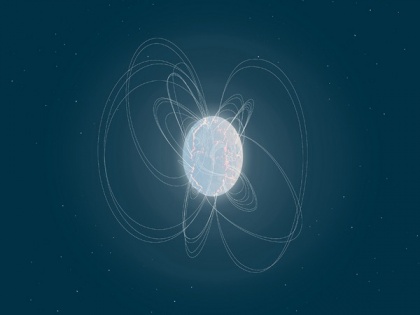Astronomers discover neutron star- a remarkable cosmic baby
By ANI | Published: June 18, 2020 12:11 AM2020-06-18T00:11:47+5:302020-06-18T18:39:59+5:30
Astronomers discovered a remarkable neutron star known as Swift J1818.0-1607, which according to the new study is only about 240 years old -- a veritable newborn by cosmic standards.

Astronomers discover neutron star- a remarkable cosmic baby
Astronomers discovered a remarkable neutron star known as Swift J1818.0-1607, which according to the new study is only about 240 years old -- a veritable newborn by cosmic standards.
NASA's Neil Gehrels Swift Observatory spotted the young object on March 12, when it released a massive burst of x-rays.
Follow-up studies by the European Space Agency's XMM-Newton observatory and NASA's NuSTAR telescope, which is led by Caltech and managed by the agency's Jet Propulsion Laboratory, revealed more of the neutron star's physical characteristics, including those used to estimate its age.
A neutron star is an incredibly dense nugget of stellar material left over after a massive star goes supernova and explodes.
In fact, they are some of the densest objects in the universe (second only to black holes) -- a teaspoon of neutron star material would weigh four billion tons on Earth.
The atoms inside a neutron star are smashed together so tightly that they behave in ways not found anywhere else. Swift J1818.0-1607 packs twice the mass of our Sun into a volume more than one trillion times smaller.
With a magnetic field up to 1,000 times stronger than a typical neutron star -- and about 100 million times stronger than the most powerful magnets made by humans -- Swift J1818.0-1607 belongs to a special class of objects called magnetars, which are the most magnetic objects in the universe. It appears to be the youngest magnetar ever discovered.
If its age is confirmed, it means light from the stellar explosion that formed it would have reached Earth around the time that George Washington became the first president of the United States.
"This object is showing us an earlier time in a magnetar's life than we have ever seen before, very shortly after its formation," said Nanda Rea, a researcher at the Institute of Space Sciences in Barcelona and principal investigator on the observation campaigns by XMM Newton and NuSTAR (short for Nuclear Spectroscopic Telescope Array).
While there are over 3,000 known neutron stars, scientists have identified just 31 confirmed magnetars -- including this newest entry. Because their physical properties cannot be re-created on Earth, neutron stars (including magnetars) are natural laboratories for testing our understanding of the physical world.
"Maybe if we understand the formation story of these objects, we will understand why there is such a huge difference between the number of magnetars we have found and the total number of known neutron stars," Rea said.
Swift J1818.0-1607 is located in the constellation Sagittarius and is relatively close to Earth -- only about 16,000 light-years away.
Many scientific models suggest that the physical properties and behaviours of magnetars change as they age and that magnetars may be most active when they are younger. So, finding a younger sample close by like this will help refine those models.
Though neutron stars are only about 10 to 20 miles (15 to 30 kilometres) wide, they can emit huge bursts of light on par with those of much larger objects. Magnetars, in particular, have been linked to powerful eruptions bright enough to be seen clear across the universe.
The Swift mission spotted Swift J1818.0-1607 when it began outbursting. In this phase, its X-ray emission became at least 10 times brighter than normal.
Outbursting events vary in their specifics, but they usually begin with a sudden increase in brightness over the course of days or weeks that is followed by a gradual decline over months or years as the magnetar returns to its normal brightness.
That is why astronomers have to act fast if they want to observe the period of peak activity from one of these events. The Swift mission alerted the global astronomy community to the event, and XMM-Newton (which has NASA participation) and NuSTAR performed quick follow-up studies.
In addition to X-rays, magnetars have been known to release great bursts of gamma rays, the highest-energy form of light in the universe. They can also emit steady beams of radio waves, the lowest energy form of light in the universe.
"What is amazing about (magnetars) is they are quite diverse as a population," said Victoria Kaspi, director of the McGill Space Institute at McGill University in Montreal and a former member of the NuSTAR team, who was not involved with the study.
"Each time you find one it is telling you a different story. They are very strange and very rare, and I do not think we have seen the full range of possibilities," Kaspi added.
The new study was led by Paolo Esposito with the School for Advanced Studies (IUSS) in Pavia, Italy.
( With inputs from ANI )
Open in app